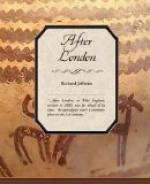The next kind of wild wood-dog is the yellow, a smaller animal, with smooth hair inclining to a yellow colour, which lives principally upon game, chasing all, from the hare to the stag. It is as swift, or nearly as swift, as the greyhound, and possesses greater endurance. In coursing the hare, it not uncommonly happens that these dogs start from the brake and take the hare, when nearly exhausted, from the hunter’s hounds. They will in the same way follow a stag, which has been almost run down by the hunters, and bring him to bay, though in this case they lose their booty, dispersing through fear of man, when the hunters come up in a body.
But such is their love of the chase, that they are known to assemble from their lairs at the distant sound of the horn, and, as the hunters ride through the woods, they often see the yellow dogs flitting along side by side with them through bush and fern. These animals sometimes hunt singly, sometimes in couples, and as the season advances, and winter approaches, in packs of eight or twelve. They never attack sheep or cattle, and avoid man, except when they perceive he is engaged in the chase. There is little doubt that they are the descendants of the dogs which the ancients called lurchers, crossed, perhaps, with the greyhound, and possibly other breeds. When the various species of dogs were thrown on their own resources, those only withstood the exposure and hardships which were naturally hardy, and possessed natural aptitude for the chase.
The third species of wood-dog is the white. They are low on the legs, of a dingy white colour, and much smaller than the other two. They neither attack cattle nor game, though fond of hunting rabbits. This dog is, in fact, a scavenger, living upon the carcases of dead sheep and animals, which are found picked clean in the night. For this purpose it haunts the neighbourhood of habitations, and prowls in the evening over heaps of refuse, scampering away at the least alarm, for it is extremely timid.
It is perfectly harmless, for even the poultry do not dread it, and it will not face a tame cat, if by chance the two meet. It is rarely met with far from habitations, though it will accompany an army on the march. It may be said to remain in one district. The black and yellow dogs, on the contrary, roam about the forest without apparent home. One day the hunter sees signs of their presence, and perhaps may, for a month afterwards, not so much as hear a bark.
This uncertainty in the case of the black dog is the bane of the shepherds; for, not seeing or hearing anything of the enemy for months altogether, in spite of former experience their vigilance relaxes, and suddenly, while they sleep, their flocks are scattered. We still have, among tame dogs, the mastiff, terrier, spaniel, deerhound, and greyhound, all of which are as faithful to man as ever.




